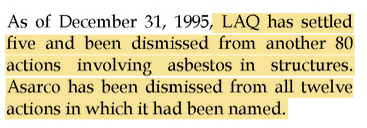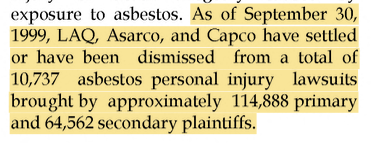Asbestos Lawsuits
The document that we are highlighting today is a compilation of lawsuits filed against many large industrial corporations, mostly from the 1990s. The lawsuits were filed by employees of these companies, claiming damages for:
"negligence, breach of warranty, misrepresentation, ultra hazardous activity and conduct, conspiracy, concert of action, market share or enterprise liability, and alternative liability."
Although each case is different and specific, we wanted to share a couple that stood out from these documents to show the kinds of issues that arise in environmental health cases.
In the 1995 case Haines v. Aetna Casualty Co., et al., seven plaintiffs sued Lac D’Amiante du Quebec (LAQ), a mining company, for supplying asbestos based products to the NY shipyard which allegedly resulted in the plaintiffs developing asbestosis. Such personal injury lawsuits arising from products manufactured by others were common, essentially alleging “a failure to warn of possible health hazards associated with those products.”
Unfortunately, the results were not often in the plaintiff’s favor; the companies didn’t manufacture the products, yet they received them from other companies and so employees were still exposed to the toxins but unable to win their case in court.

In December of 1995, there were many different types of cases being processed against LAQ and Asarco, another mining firm, including class actions involving colleges, universities and public buildings in cities. The cases sought “substantial compensatory and punitive damages.”
Once again, almost all cases were dismissed.
Finally, we wanted to show just how many people were filing lawsuits against just these two companies.
Although the document does not mention the total number of lawsuits, that is an alarmingly high number of people bringing cases. One document mentions 179,450 primary and secondary plaintiffs whose plea for damages as reparation for personal injury from asbestos was overturned, often because of technicalities like their employer was not the manufacturer of the product which contained asbestos.
Health justice through courts was isa longwinded and often frustrating process; even in the face of medical evidence, corporate case law and judicial process did not immediately respond to alleviate these deadly industrial exposures.


